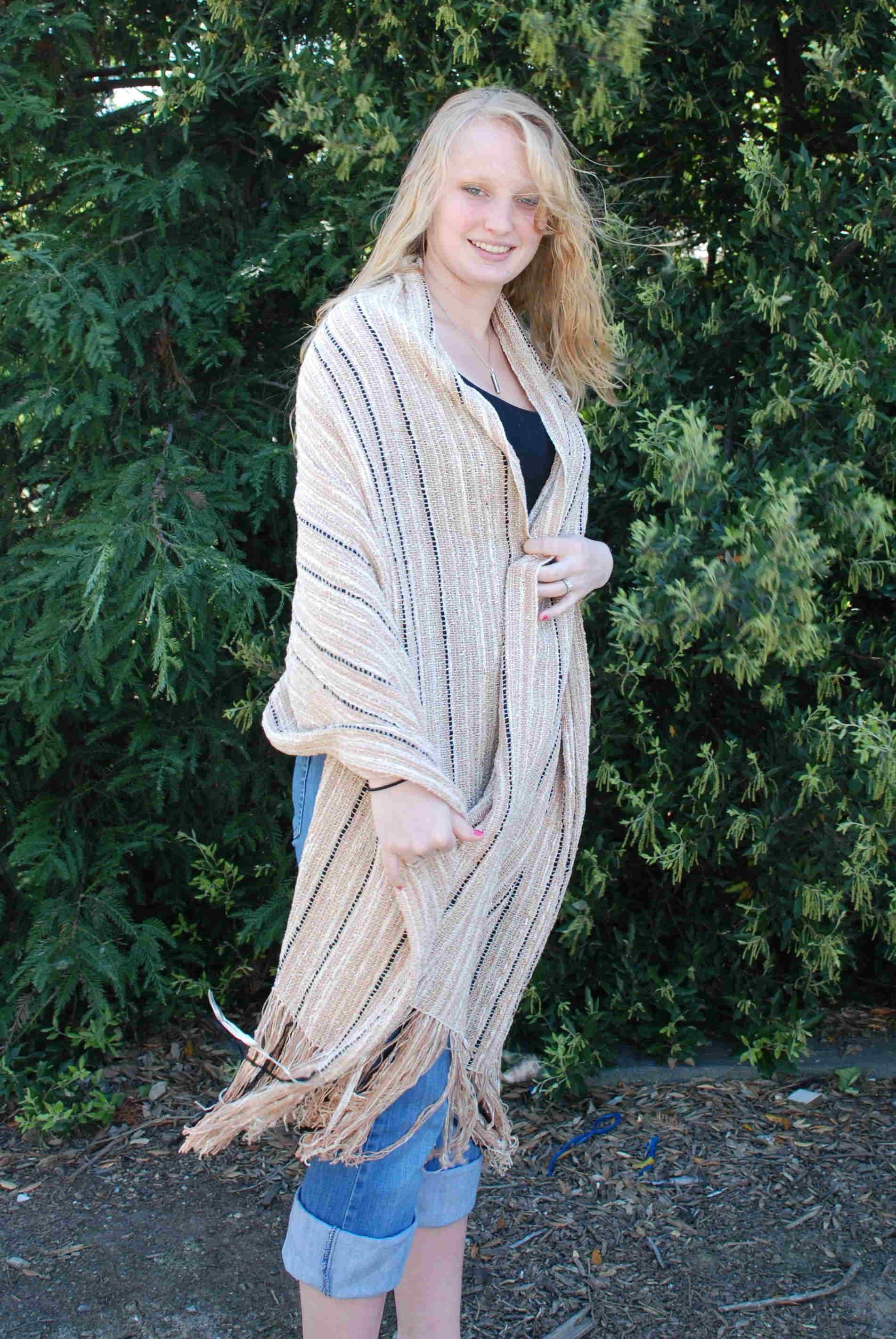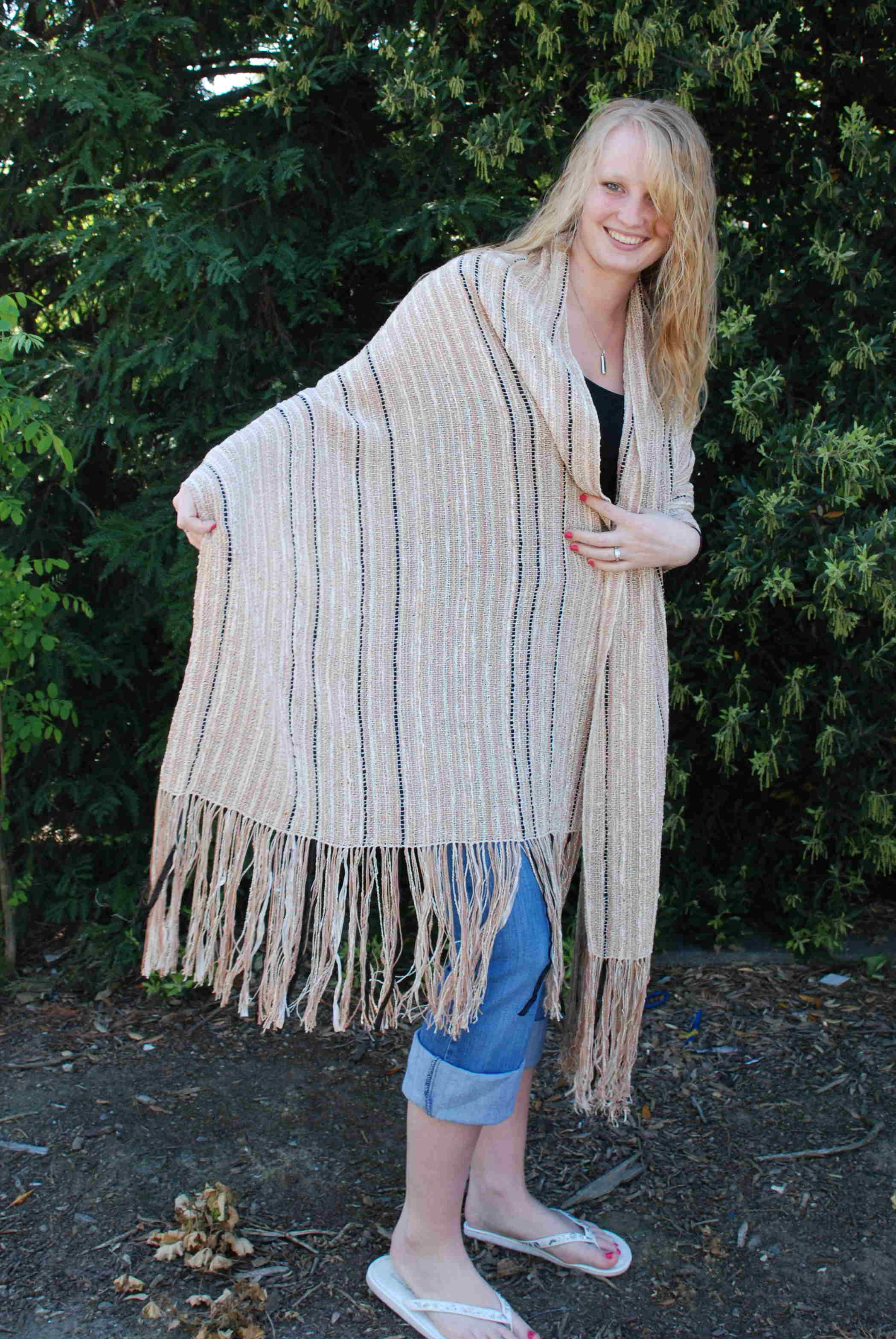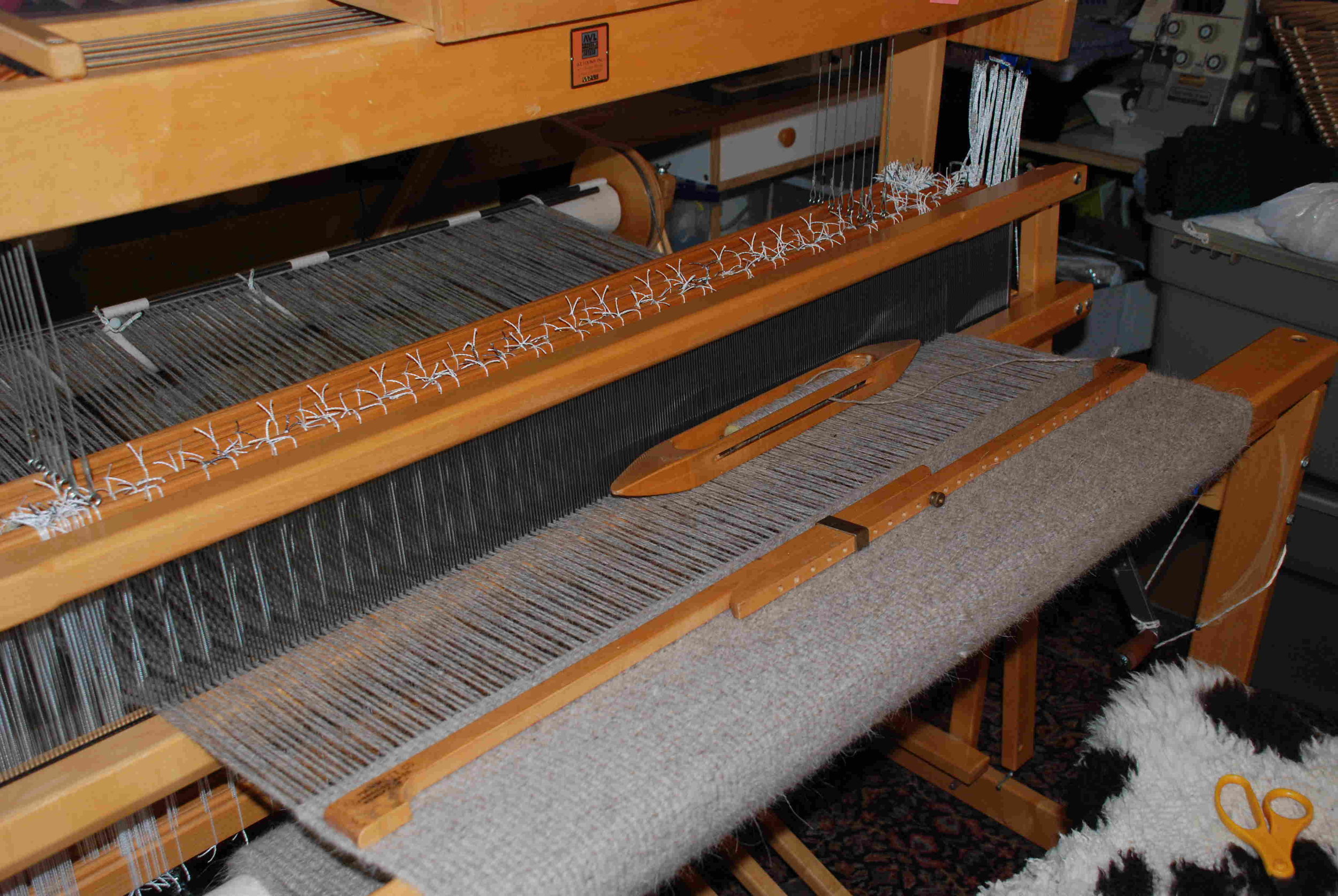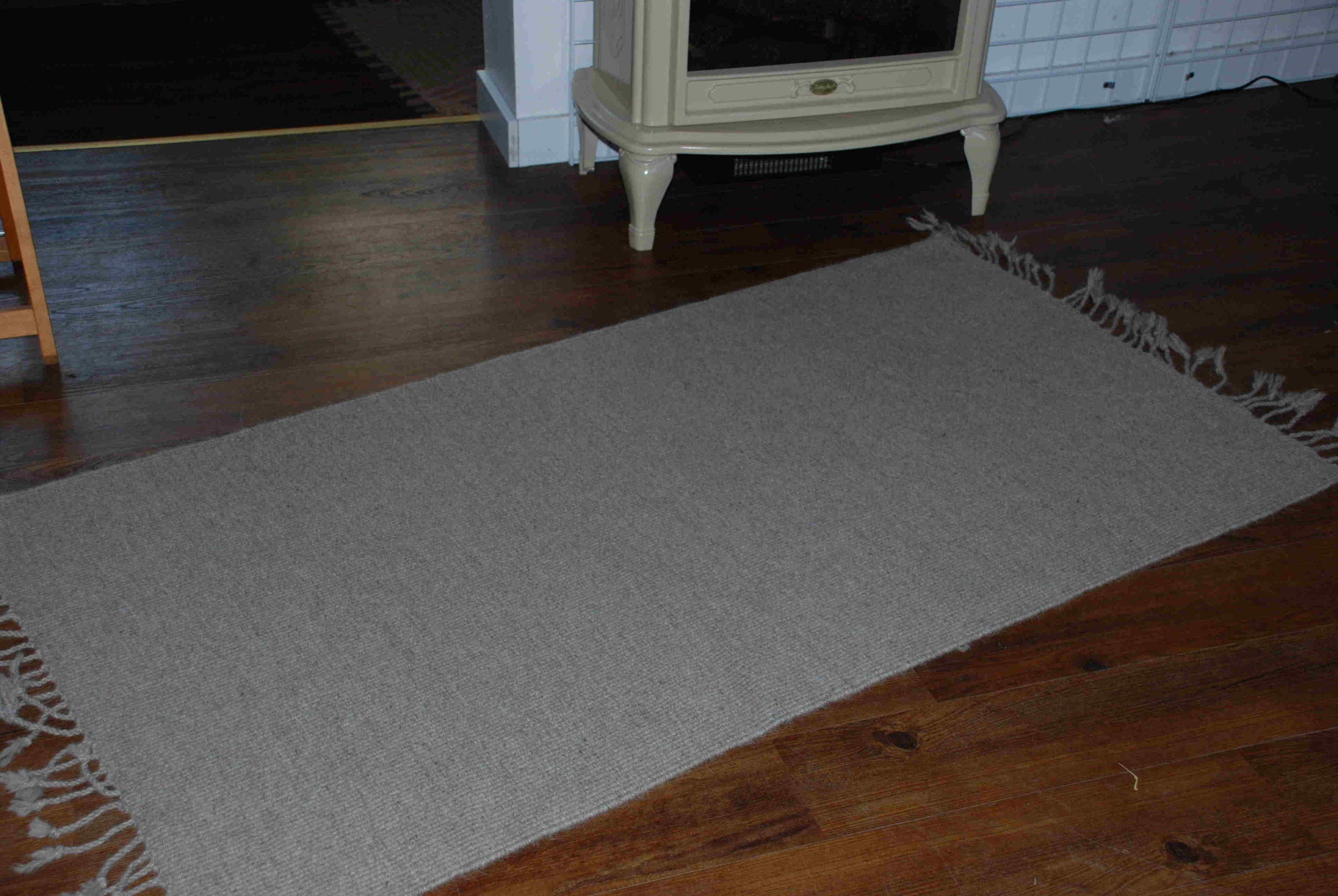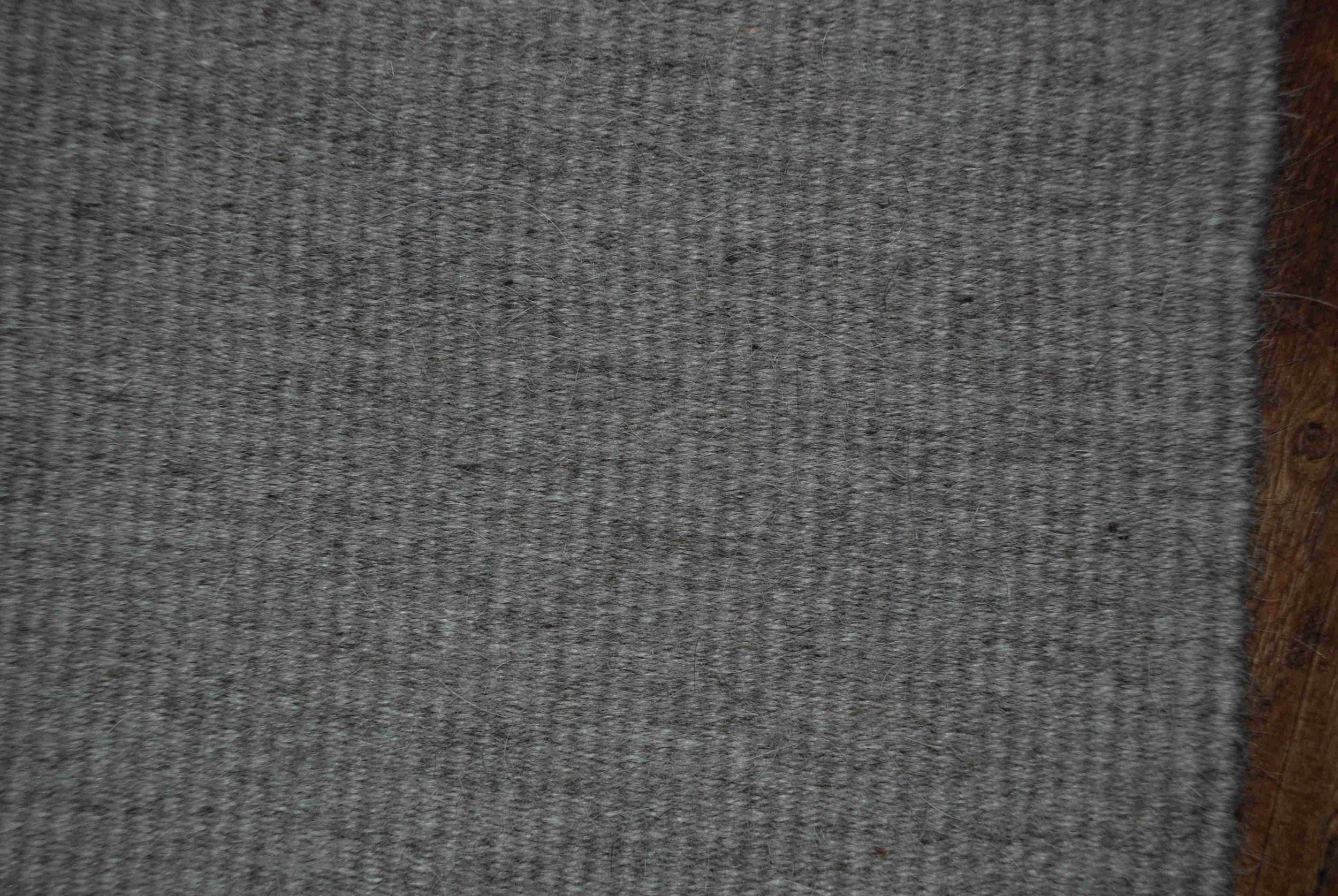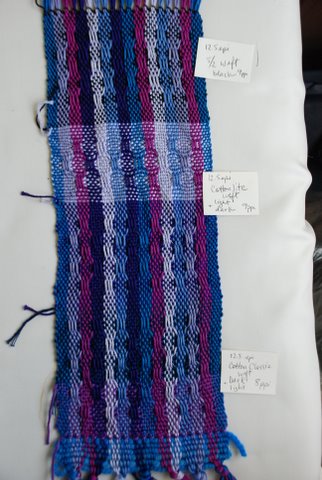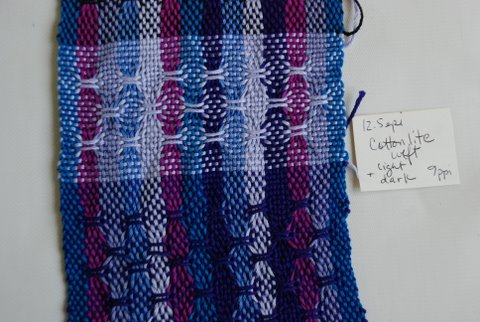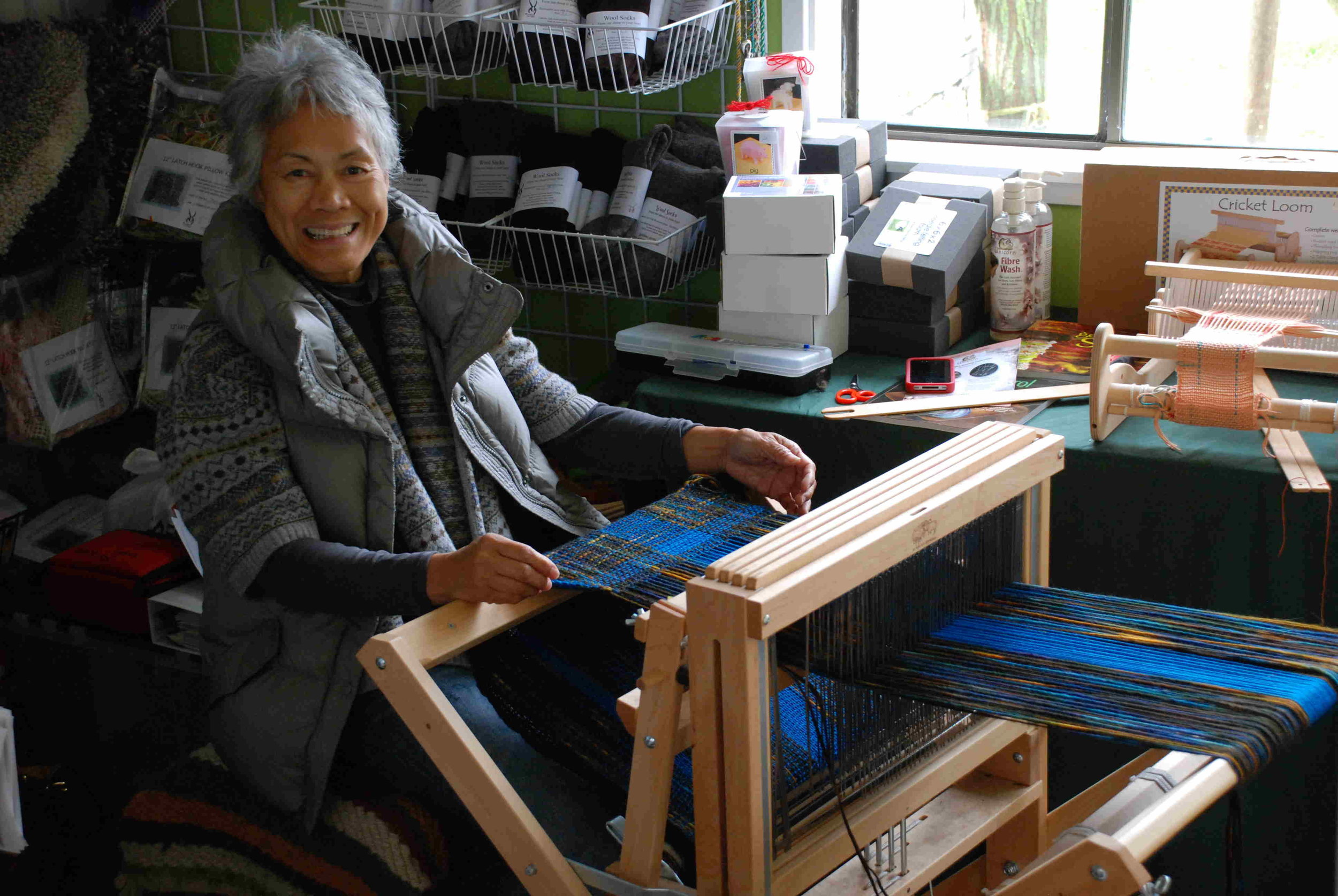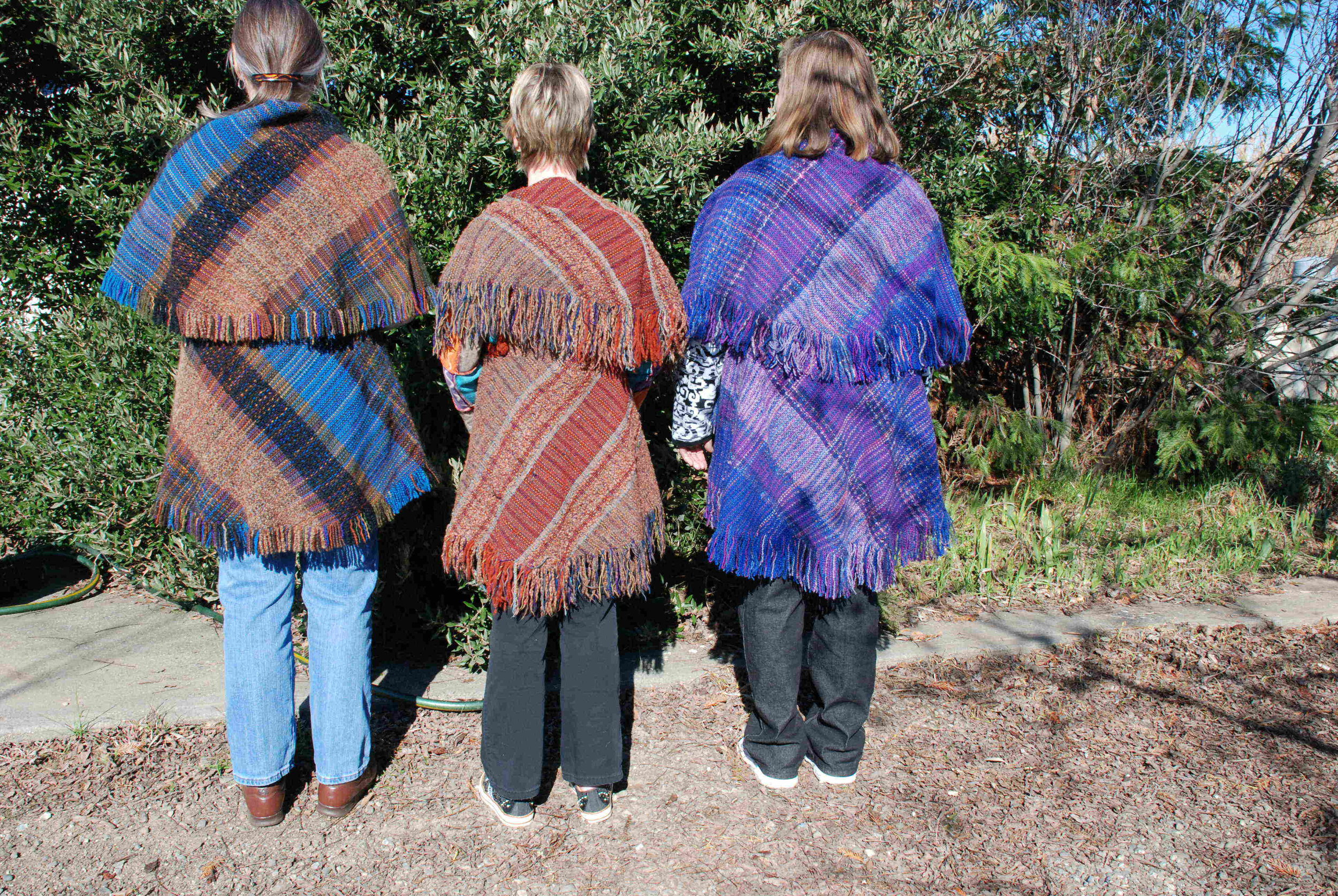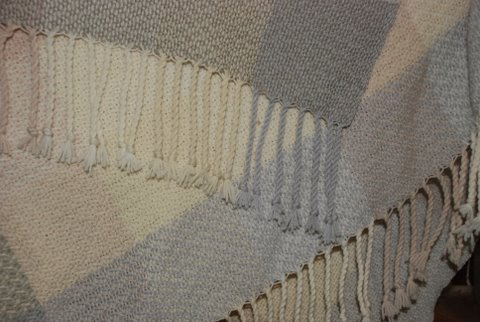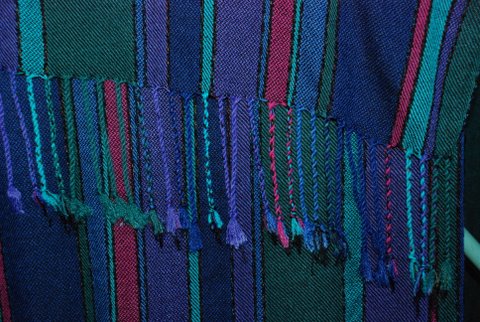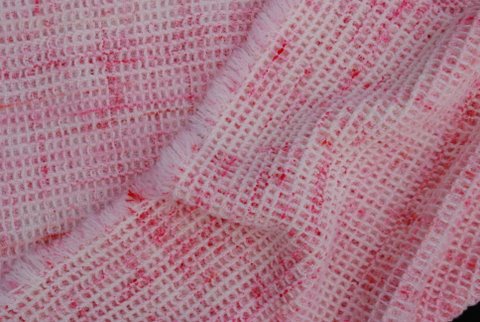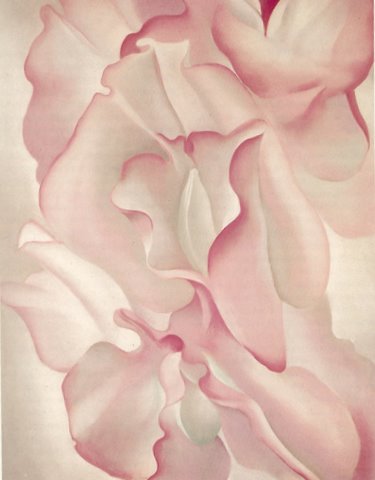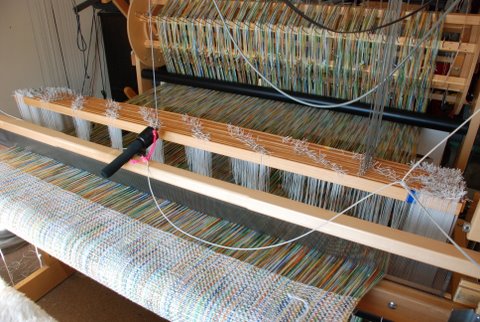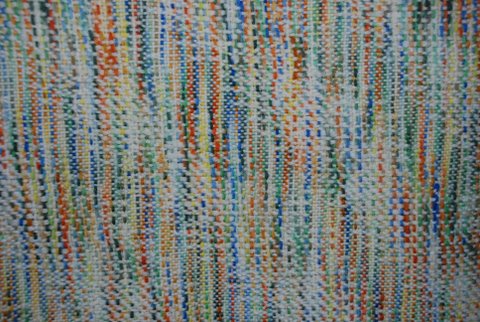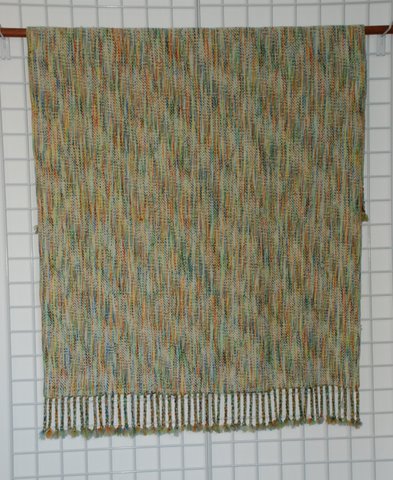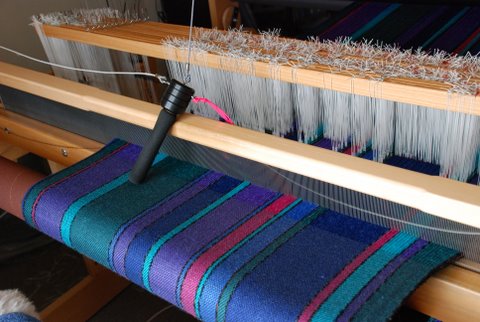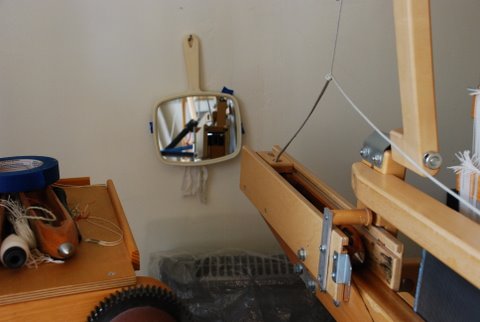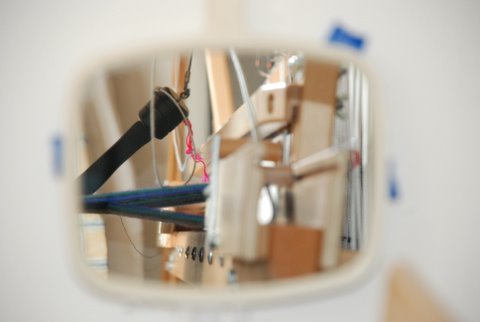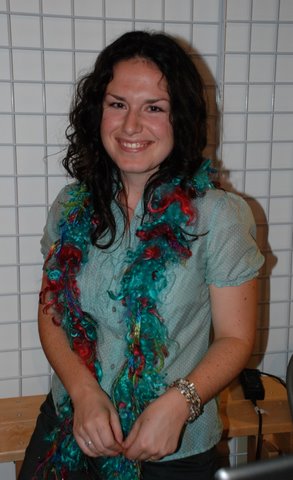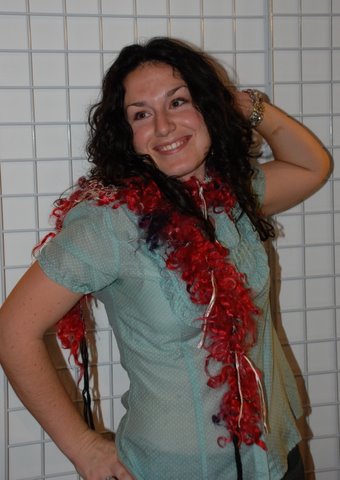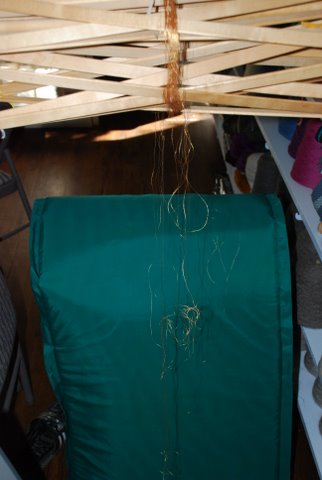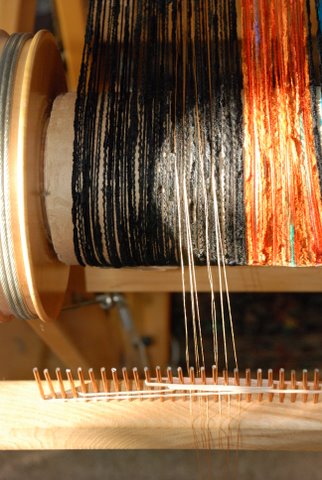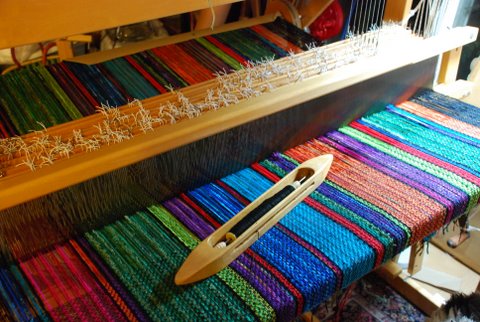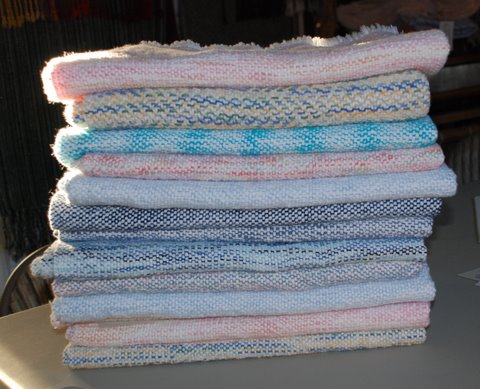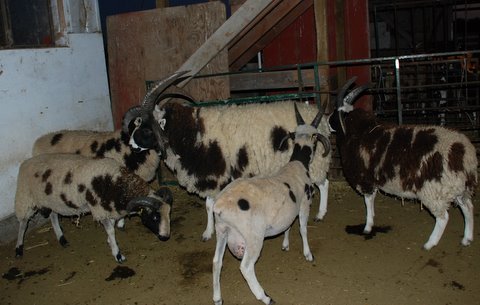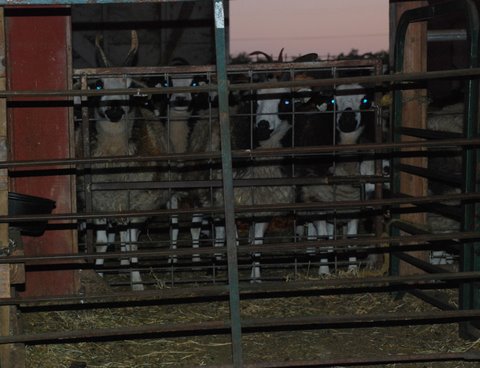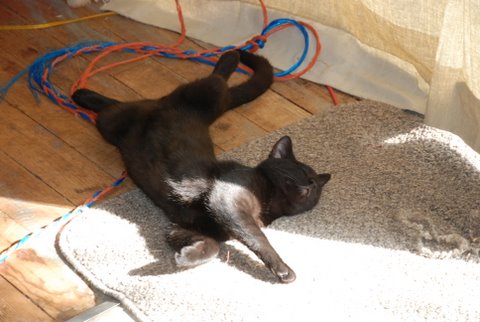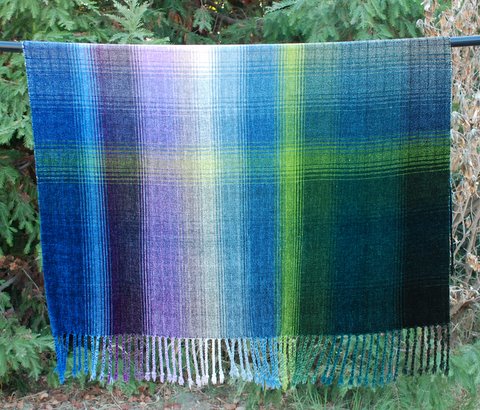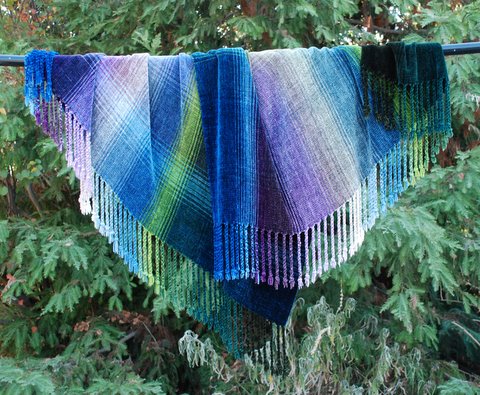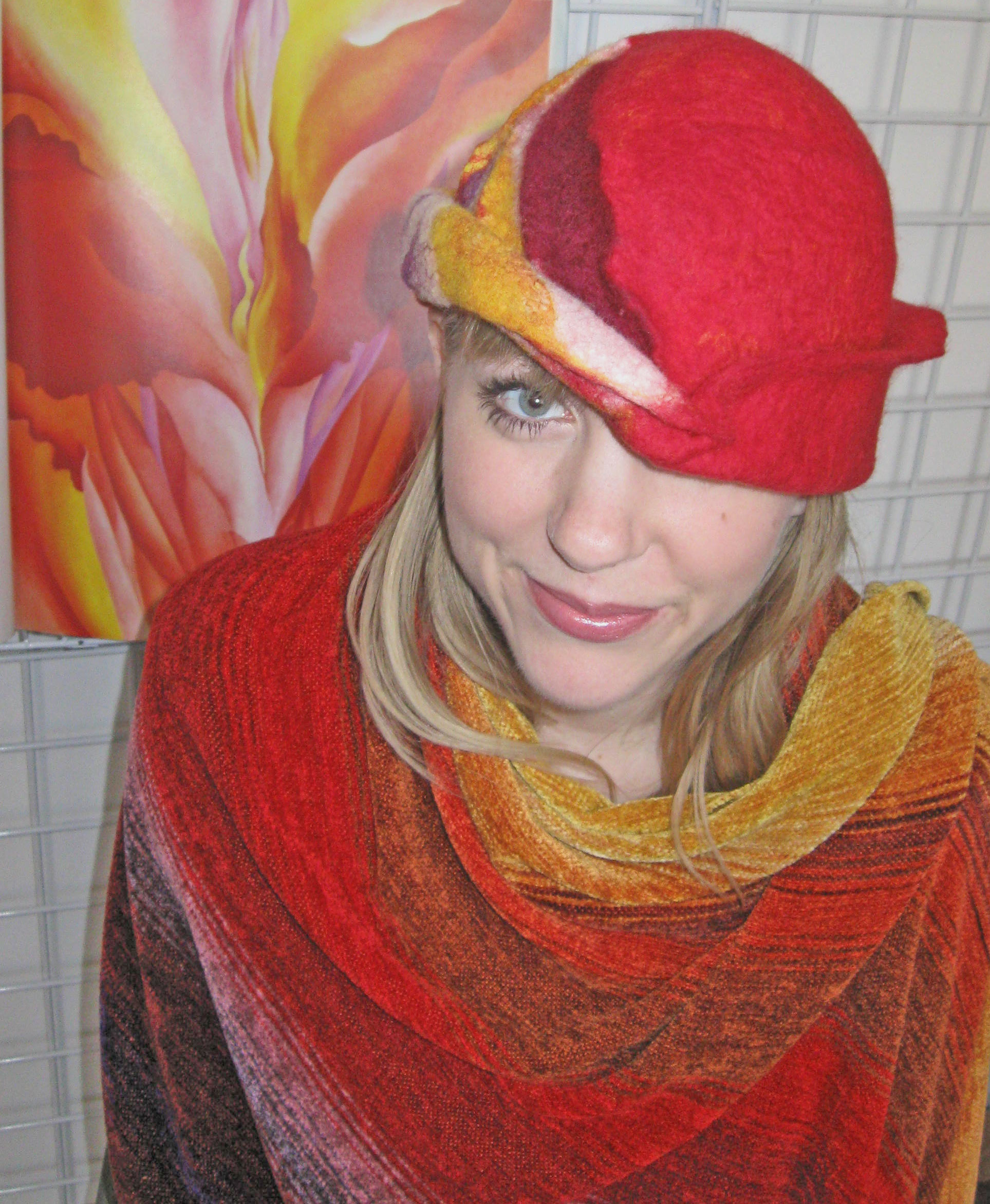Three Looms Warped
/I have new projects on all three looms. That's exciting! This is a warp for 2 shawls. It is a mixed warp of cotton threads, a shiny slubby rayon thread, and Luna ribbon. I have already completed blue and purple shawls in my series of shawls for the Artery.
This is a warp for 2 shawls. It is a mixed warp of cotton threads, a shiny slubby rayon thread, and Luna ribbon. I have already completed blue and purple shawls in my series of shawls for the Artery.
 I know it's 100+ degrees out but I'm getting a head start on the projects for the winter and I couldn't wait to try out my new yarn. This is the newest Jacob yarn (1 ply black and 1 ply light gray)--not even labeled or on the website yet--and the project is a v-shawl.
I know it's 100+ degrees out but I'm getting a head start on the projects for the winter and I couldn't wait to try out my new yarn. This is the newest Jacob yarn (1 ply black and 1 ply light gray)--not even labeled or on the website yet--and the project is a v-shawl.
 I have been low on baby blankets for quite a while and while this warp may not help when someone needs a "boy blanket" it should give me several for girls--it's 24 yards. Someone called today looked for a "neutral" blanket and I wonder if I weave with a blue thread if it could go for either. Here's a small world experience. Yesterday I got an e-mail from a young woman New York who had been sent one of my baby blankets when she was a baby and her mother has been a regular customer ever since. The daughter now has a friend who is pregnant and wants to give one of the baby blankets. The call today was from the person who sent that first blanket to his niece in New York and now wants to send a blanket to Germany.)
I have been low on baby blankets for quite a while and while this warp may not help when someone needs a "boy blanket" it should give me several for girls--it's 24 yards. Someone called today looked for a "neutral" blanket and I wonder if I weave with a blue thread if it could go for either. Here's a small world experience. Yesterday I got an e-mail from a young woman New York who had been sent one of my baby blankets when she was a baby and her mother has been a regular customer ever since. The daughter now has a friend who is pregnant and wants to give one of the baby blankets. The call today was from the person who sent that first blanket to his niece in New York and now wants to send a blanket to Germany.)
Black Sheep Gathering-Day 2
/Here are a few scenes from today's events.

All the champion ewes and rams return to the show ring for selection of Supreme Champion. Theron and I represented the Jacob breed.
The winner was Terry Mendenhal's beaufiful Merino ram, the third white sheep from the left in this photo.
The Spinner's Lead competition was held in the evening after a huge potluck dinner. We were last of 18 entries and had the biggest applause of all (thanks, all you CA friends). Chris, Jackie and I all wove v-shawls from Jacob fiber and had a good story to explain all the details. It's too late for me to explain more, so here is another photo.
We are having a great time! More tomorrow.
Silk Challenge-Part 2
/When I have new fibers or yarns and am trying to figure out how to use them my first step is to sample. Sometimes this is a full-sized sample. For instance I go ahead and weave a blanket or a scarf, etc and learn as I go how the yarns work together and decide if I like it or if I should change something next time. The silk challenge poses a different problem for me. I don't have any idea of how these yarns will work and I don't really have an end project in mind although a scarf is one idea. By the way, the responses to the last blog were good ideas
- color and weave effect
- accent colors on woven sheep as in some very cool sheep paintings that Dona sent
- fabric for the "squares jacket" that Diane brought to WWW
Wedding Shawl Commission
/Last month I posted the following photo that shows the array of yarns that were chosen by a friend for her daughter's wedding shawl.
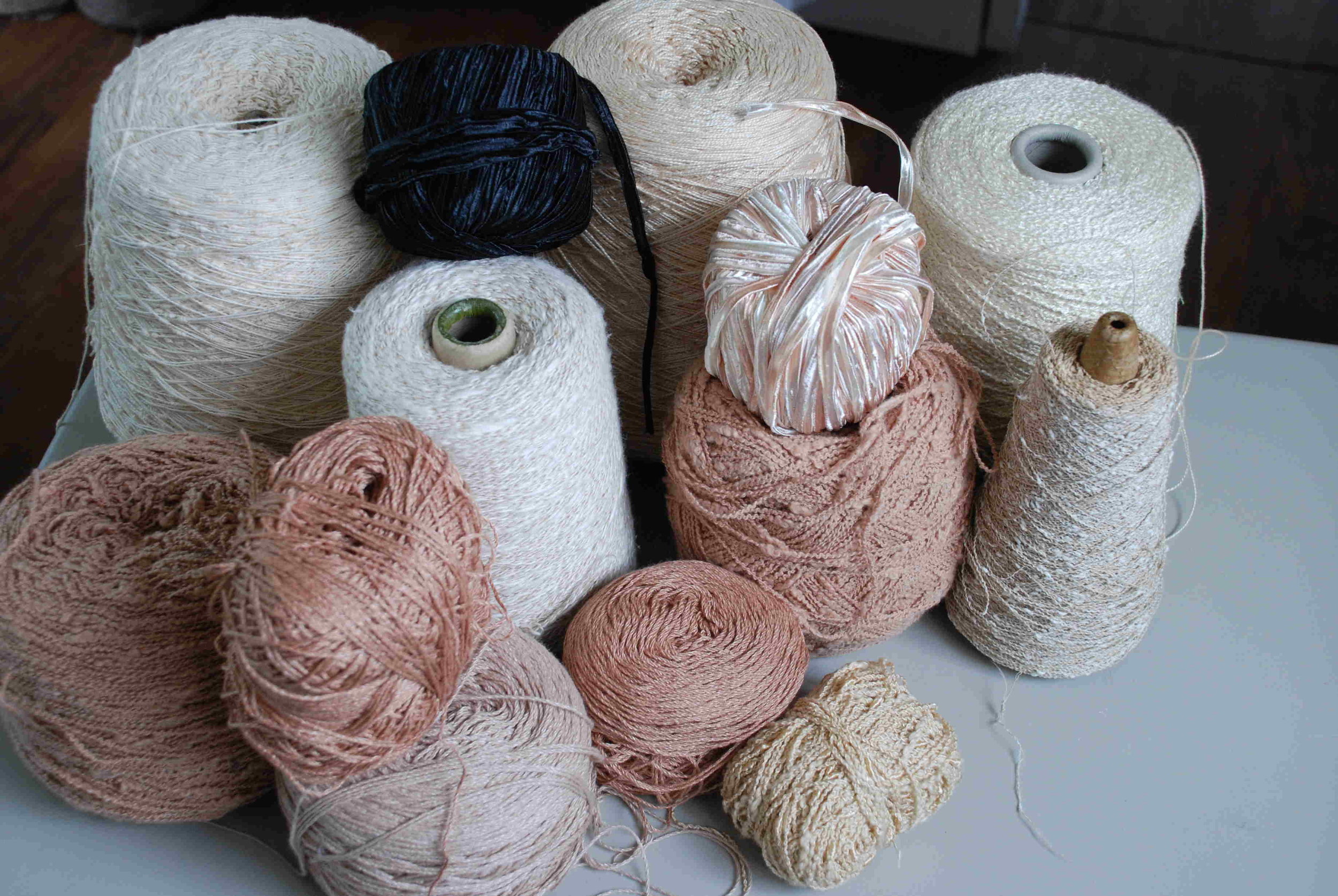
My friend originally planned to weave the shawl herself but then commissioned me to weave it.
This is the warp on the loom. I was concerned that the white weft was going make the shawl too white. No need to worry. It came out just right.
In this close-up you can see the variety of yarns used in the warp. The weft is relatively fine with a regular slub that helps keep the yarns in place even though the shawl is loosely woven.
My favorite model just happened to be here before my friend was to pick up the shawl. (That's my daughter visiting from VT.)
I got the report back from my friend: "My daughter loves her wedding shawl!! She says it's the most beautiful shawl she has ever seen!! That's a compliment from my very fussy and stylish daughter!"
I am not a rug weaver.
/A llama and alpaca owner sent me his mill-spun yarn to weave blankets. The alpaca yarn was OK for blankets, but not the llama--way too much coarse fiber. I wove samples to send to him.

I used the alpaca yarn for the lower left sample. The other two are using llama yarn. I wove them weft-faced as you normally weave a rug. However I am not a rug weaver. There is a lot involved in weaving a firm, sturdy, even rug and, although I admire handwoven rugs greatly, I don't plan to be a rug weaver. I struggled with this project. I wove the first rug a few months ago and wasn't happy with it. I was determined to weave at least one rug in my life that was adequate.
I have never used a temple before but did for this project. The temple is that adjustable wooden bar. It has sharp teeth at the ends and you move it forward every inch or so to keep the weaving width the same throughout the piece. This is slow weaving in comparison to what I'm used to.
Here is the finished rug with a detail below.
Artful Fiber Again
/The weaving show I presented at the Artery in November was featured in the March/April issue of Handwoven magazine.

I am amazed at how many pieces the editor fit into a two page spread.
Today this article was mentioned in Interweave Press's blog: Weaving Today.
Learning a new Rigid Heddle Technique
/My friend and business mentor, Irene of Cotton Clouds asked me to weave a scarf as a sample for the Coloring Contest for Weavers that is on her website. Usually I can whip up a scarf in a few hours, but with an "irene project", as I fondly refer to our endeavors, there is always something that slows me down. This scarf was to be on the rigid heddle loom AND using a pick-up technique. I have been planning to teach myself those techniques, but have never quite got around to it. Well, now was the time. Irene sent me several colors of Cotton Classic and Cotton Classic Lite yarn and I started to play around with color order. I chose a warp float pattern out of The Weaver's Idea Book by Jane Patrick. The pattern unit is six threads so I wanted to make the color changes in 6 thread increments. I arranged the colors randomly with the exception of using the same color at each edge. Here is the sample I wove. I used the heavier Cotton Classic first (bottom of sample) in purple and navy, then the lighter Cotton Classic Lite in navy and then lavender, and then black 5/2 cotton.
This is a detail of the middle part of the sampler. Notice the huge difference there is depending on the value of the yarn you use. These two sections are the same pattern but the lighter yarn shows the pattern as circles. The darker weft accents the warp floats.
This is the back of the sample. Warp floats on one side mean weft floats on the other.
I like both effects but decided to use the darker yarn for the final scarf. I made other changes as well. When you look at the top photo what does your eye see? I first notice the light value stripes. I decided that was too distracting. I also decided to vary the size of the stripes. However I didn't have enough yarn to wind another warp. So I removed the lightest value yarns from the warp and rearranged the other yarns in the rigid heddle, adding a few more warp ends as needed. Then I wove with purple. The result is below. Unfortunately the color of the photo below shows up differently than the photos above even though these are the same yarns. (But the trials and tribulations of photographing weaving are another story.)
Another bonus of this project--I love this pick-up technique. it's not hard at all once you get used to the pattern. I can see more of these in my future.
Green scarves from blue and red jeans
/I get tired of over-worked words to describe concepts which aren't all that new. Maybe it's good when more people start to understand the principles being described. Green is one of those words...and concepts. But I couldn't pass up using it in the title of this post. I honestly don't know how this yarn is processed but it is 100% recycled jeans and I wove the scarves with no energy except my own.

The yarn is called Riveting and is sold by Cotton Clouds . The scarves are woven on a Huck Lace threading.
V-Shawl Class
/I taught a v-shawl class last week. It's always fun to see the variety in these shawls. The v-shawl is warped for double weave. The fronts of the shawl are woven with two shuttles and the back is woven by cutting one pair of warp threads at a time and weaving them in as weft.

Tina chose natural colored Rambouillet and Jacob yarns.
Jackie used brown Rambouillet and a space-dyed yarn for accent.
Marilyn used softball cotton in natural and tan with accents of ribbon and a novelty yarn.
Yolanda has space-dyed wool yarn with a blue stripe.
These are the shawls right off the loom so there has been no finishing of fringes.
 The back view shows the designs that you get from the warp stripes.
The back view shows the designs that you get from the warp stripes.
A Fiber Weekend
/I spent the weekend at the Sacramento Weavers and Spinners Open House. When I wasn't helping in the Sales Area I demonstrated carding with my Ashford drum carder. I chose a fleece from the November shearing and washed it in two batches. I also wanted to experiment with my new Power Scour to find out how much I needed to get the wool clean. The first 2 pounds of greasy wool weighed about 1 1/2 pounds when cleaned. I don't think I got all of the lanolin out so I'll probably increase the amount of Scour for the next batch. Even if there was still a bit of lanolin in the fiber it carded beautifully. I took this batch to the Open House on Saturday and here is what it looks like after carding.

That will provide a lot of spinning time. I was sure impressed with the drum carder. It breezed through that fiber.
These are a couple of skeins spun by a friend of mine using fleeces she bought from me. Aren't they lovely? The wool in the lower skein is blended with carded sari silk which adds beautiful flecks of color.
This is a close-up of one of the pieces I had at the show. It is a tencel scarf woven in undulating twill.
There are some very talented weavers in SWSG. Here are a couple of stunning pieces woven by members.
The warp for this screen is silk covered wire and it is woven with rice paper "yarn" if I remember correctly. (I thought that I'd remember from yesterday to today without taking a close up photo of the tag.)
The meaning of WWW
/To my friends it means Weekly Weaving Workshop. It is usually the Wednesday Weaving Workshop, but is sometimes on Friday. I have had a request for an evening group. Is that EWWW? Maybe not.

Modeling three circle shawls. The one in the middle is the prototype that Diane brought a year ago. We analyzed the fabric construction and the design of the piece, after which Chris and I both wove shawls. Check out the back of these shawls:
Yesterday's WWW was truly Wonderful--soaking up the January sun and talking about our favorite pastime!
Maybe I'll change the name to WX4= Wonderful Wacky Weaving Women.
Tired of twisting
/We're setting up the Artery show on Thursday so instead of weaving all day I twisted fringe all day. I don't particularly like twisting fringe, but I think that most of the things that I weave are best finished with a twisted fringe.
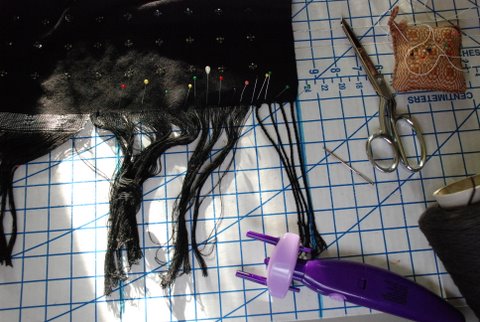
This is a shawl woven with fine bamboo yarn. If I leave the fringe loose it will get hopelessly tangled in use. Also, the bamboo yarn seems to separate into it's plies fairly readily. So twist it is.
When I weave wool blankets I count on fulling them in the finishing process ( agitation in hot soapy water). The threads become somewhat attached to each other and the whole thing becomes a cohesive unit instead of a bunch of intertwined threads. That is not the process that you want for loose fringe. Twist again.
The green and brown blanket has already been washed. This light blanket (inspired by clouds in a painting of the Sierras while the green one represents the forest) has not been washed.
I wove this ruana fabric a few weeks ago but hadn't twisted the fringe. Even though I had woven a lot of items I had hours ahead of fringing. Now I think I have just one shawl left and the scarf that I'll finish tomorrow.
O'Keefe and Courbet weaving
/I wove these projects a few weeks ago but just got them finished--that is, I wet-finished them. When a weaving comes off the loom it is not considered finished until it has undergone some kind of treatment. That could be anything from gentle soaking in water and spreading out flat to dry to vigorous processing in the washing machine and dryer. Whatever finishing process is chosen it changes the character of the project, sometimes dramatically. The finishing method should be factored in to the planning of the project.
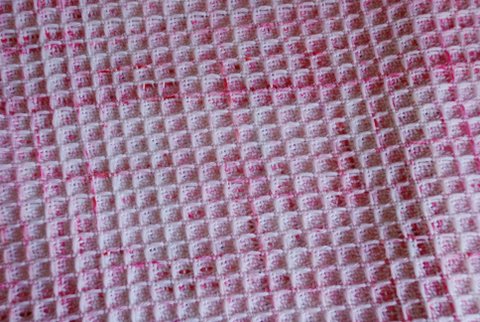
This is a waffle weave blanket woven in Jaggerspun Lambspun wool that I sell. It is machine washable and won't felt with washing. It does change character however.
This is the same blanket after going through the washer and dryer. The inspiration for this blanket is the following Georgia O'Keefe painting. I started with white yarn and sprinkled dye powder over the yarn to get the varigated shades.
I love the subtle colors of this painting, but I also love the vibrant ones in the next.
Seascape by Courbet. I used the same washable wool yarn for this project. I wound the warp and then dyed it. Here is the finished v-shawl.
Van Gogh blankets
/After the ruana project (which still has not been sewn, fringed, or washed) it was a relief to do something easier. This project was inspired by this Van Gogh painting.
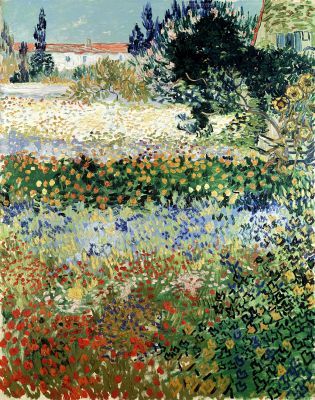
I dyed yarn. This is Jaggerspun Superlamb, a washable Merino yarn. I usually don't leave white spaces in the space-dyed yarn, but there is a lot of white in the painting so I thought that I needed it here.
I warped the loom for two blankets in an advancing twill.
The color in the detail shot is more true. It's a soft blanket with a nice drape.
Weaving day
/I spent most of the day at the loom weaving a project that it taking way longer than I expected. I planned to weave a ruana for the show coming up and I based the measurements on the ruana that my daughter wove way back when she was 11 years old.
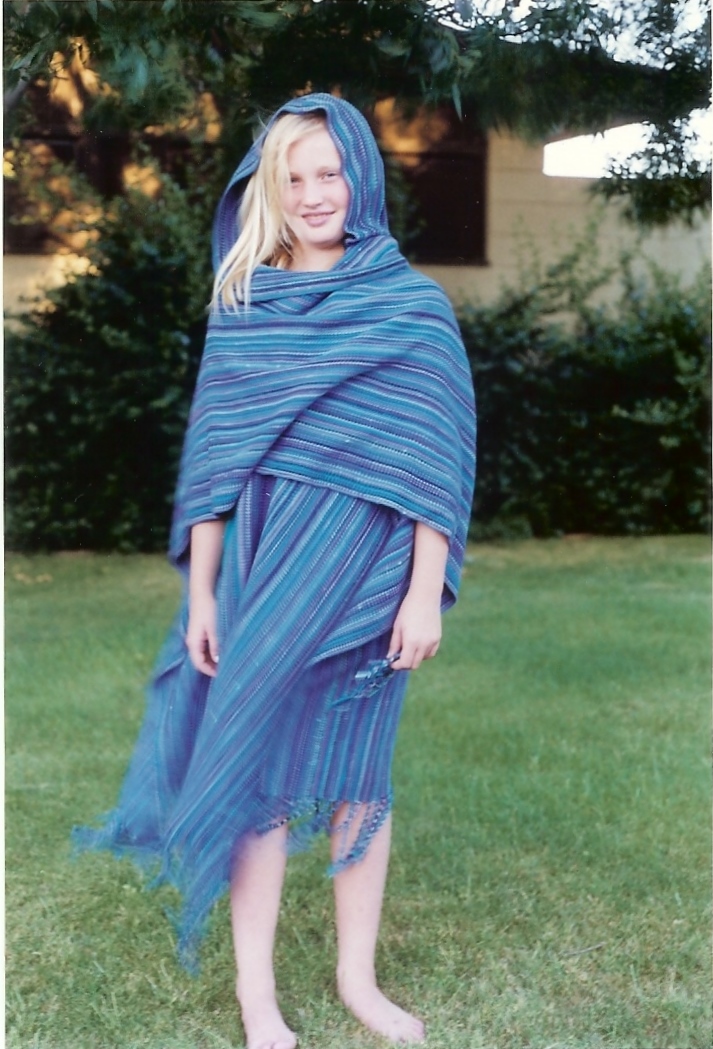
When I took the measurements of this piece I assumed that we had warped this using double weave--to come up with a double width fabric in the back and two separate layers for the fronts. That was assumption #1 that was wrong. I planned colors of stripes to coincide with two twill patterns. As I was winding the bouts of warp I put them in the raddle for my AVL 8-shaft loom. It occurred to me part way through that I needed 16 shafts to weave the 2 layers that I planned. OK, no problem. Since I hadn't yet wound the warp onto the beam I could move the warp to the 16-shaft AVL. This was a tedious project to thread. With the help of the computer (and a lot of trial and error) I figured out how to thread this and then have the twill lines reverse on the bottom layer.
I also used the computer to figure out how avoid 3-thread floats between the transitions of the two patterns. This is one layer (shafts 1-8). I did another draft for the 2nd layer (shafts 9-16) and then interspersed the tie-up to create double width and again for two layers.
Here is the fabric on the loom. I am using the Zephyr 50% wool/50% silk yarn that I carry in my shop. The big mistake I made was planning this at double weave instead of just weaving one really long strip and sewing them up the back. My assumption about the original ruana was wrong--we did it just that way, not double weave. I'd have been finished a long time ago if I had woven one long strip. The double width isn't so bad except that the yarn is so dense that I had to pay close attention to make sure that threads weren't catching. Here is the system I rigged up for that.
A glance in the mirror each time I change sheds shows if it is clear or not.
The harder part is now that I'm weaving the two separate layers. Two shuttles is much slower than just half the speed of using one shuttle. I think I have another couple of hours tomorrow and then this warp will be finished and I can move on to other projects to finish in the next two weeks.
Here is a weaving project that is very different from the ruana. In a previous post I showed this pile of mohair and yarn scraps that was working on in Oregon:
This is what it turned into. Thanks to the ever willing Shelby for modeling. (Without a model it would probably not look much different than how the fiber looks piled on the table.)
A few days ago I wove another.
This will be in the Artful Fiber show at the Artery to accompany this painting:
There is something about this painting that makes me think of a fluffy boa.
Solano Grown debut
/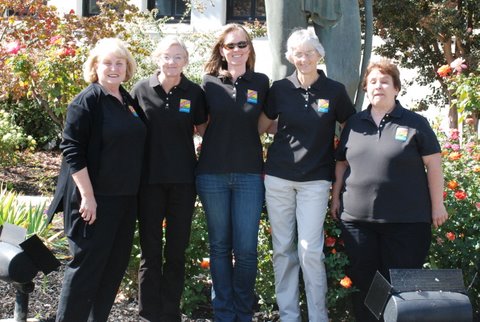 Here we are in our spiffy new shirts standing in front of Chief Solano after the Board of Supervisors meeting in which we presented Solano Grown. If you really want to see Chief Solano you need to see this photo.
Here we are in our spiffy new shirts standing in front of Chief Solano after the Board of Supervisors meeting in which we presented Solano Grown. If you really want to see Chief Solano you need to see this photo.
Although the presentation was only about 5 minutes we were in Fairfield from 9:30 to about 1:30. We had to wait a few hours until it was our turn and then we worked on a few more things to be ironed out as far as logo use and membership guidelines.
Finally back home, I worked on untangling the gold thread for the project on the loom now.
I have added the gold thread as a supplemental warp in part of the black border, but it doesn't show up very well.
What do I do all day?
/What have I been doing all week? Way too much to write down and maybe not all that interesting. But I'm so busy that although I'm always taking photos and thinking of good blog posts I just haven't had time. Here are bits and pieces of this week.
I finally wove some more baby blankets. I have customers waiting. After I took the blankets off the loom I realized that I had a lot of skipped threads along the left side of many blankets. I know why--has to do with combining 7 threads as one in the warp and trying to use 2 threads wound together on the pirn with a fly-shuttle. Just enough drag on the shuttle to cause it to catch the warp threads. AHHHH. That means a lot of fixing. My $/hour just went WAY down. Here are some of the 17 blankets.
These blankets will be on my website after I get better photos. That's another thing I spent time on. I tried in the sun and in the shade and none of the photos were very good. Back to the drawing board.
I have projects on three looms right now. Two are for the November show at the Artery. One is for my friend, Irene, owner of Cotton Clouds. That project will be a surprise, but here is a preview:
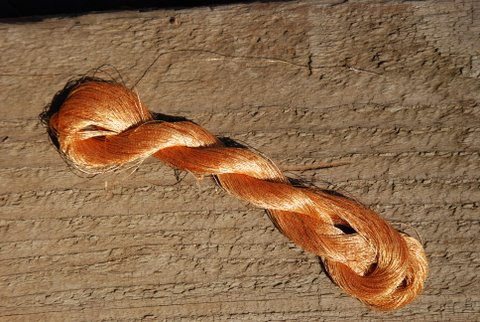 14 carat gold thread--use sparingly!
14 carat gold thread--use sparingly!
This is more of the project. All of these yarns are going into the warp!
In the meantime there are sheep things going on. Savor, one of the yearling rams, had been with a group of ewes and I needed to put him somewhere temporarily. I didn't want to put him back with his buddy, Tioga, because I figured that they'd have to fight it out first and I can't deal with that right now. So I gathered up the ram lambs that are left and put them all together. Usually the lambs bow down to the older and stronger ram and leave him alone. There is posturing, but if they know what's good for them they won't antagonize the big guy.
At first I thought it would be OK.
They look friendly enough, but finally Savor started threatening one of them more seriously. It happened to be a ram lamb who is already sold for breeding but hasn't gone to his new home yet. I needed to separate them because I didn't want to take a chance.
The ewes were all looking hopeful that they would get a chance to mingle with the rams. "We're ready! Come hither!" Notice the double fence.
Last but not least--someone in this house has no problem taking naps:
Petunias off the loom
/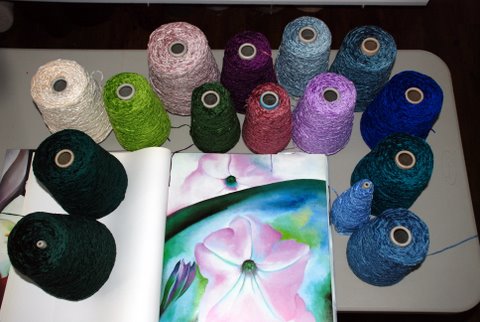 Remember this photo? Here are the results of my weaving:
Remember this photo? Here are the results of my weaving:
I made a warp long enough for two throws. (They were going to be shawls but because I wanted to keep all 16 colors the warp was too wide to turn into shawls.) This photo is a throw woven with a fine cotton weft so which you see the warp stripes, although it's hard to really see all the colors.
I wove the second blanket with chenille yarns in the same colors and order as in the warp. If you could see the whole blanket you'd see that it starts with green on this end and finishes with blue on the other.
Julia, who is the felting half of the November Artery show, and I got together a couple of weeks ago to get a photo to be used for publicity.
Julia brought Lisa, her neighbor's daughter visiting from New York, who graciously agreed to be our model.
Isn't she great?
I could weave O'Keefe inspired fabrics forever, but it's on to Mondrian.













